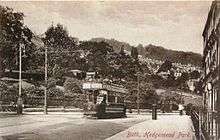Bath Tramways
| Bath Tramways | |||||||||||||||||||
|---|---|---|---|---|---|---|---|---|---|---|---|---|---|---|---|---|---|---|---|
 A tram heading towards Bathford | |||||||||||||||||||
| Operation | |||||||||||||||||||
| Locale | Bath | ||||||||||||||||||
| |||||||||||||||||||
| |||||||||||||||||||
Bath Tramways Company and its successors operated a 4 ft (1,219 mm)[1] horse drawn tramway service in Bath between 1880 and 1902.[2][3] From 1903 until its closure in 1939 and expanded route carried electric trams operated by Bath Electric Tramways Company.
History
The first service ran on 24 December 1880.[4] The initial 4 ft (1,219 mm) line was from the Bath Spa railway station via Southgate Street, High Street and Walcot to Grosvenor College.[5] It used six horse drawn cars built by George Starbuck of Birkenhead, with a stable and depot in Kensington.[4]
The service was not profitable and on 26 May 1884 the company was taken over by the Patent Cable Tramways Corporation. Seven further 12-seater cars were purchased. It entered liquidation and was taken over by Dick, Kerr & Co. on 11 August 1888. This was taken over by the Bath Road Car and Tramways Company, who already ran the busses in the area, on 1 April 1889.[6] The horse drawn service continued until 1902 when the company was taken over by Bath Corporation and modernised and electrified by the Bath Electric Tramways Company, a subsidiary of British Electric Traction.[7]
.jpg)
The 4 ft (1,219 mm) tracks were taken up and replaced by a 4 ft 8 1⁄2 in (1,435 mm) track. Six electric cars were brought in December 1903 and on 2 January 1904 the new service opened. Additional lines to Bathford, Combe Down, Weston and Oldfield Park were constructed. The company fleet was blue and yellow. There were 18 55-seat tramcars all purchased in 1903 and 1904 from G.F. Milnes & Co. which operated from a new depot in Beehive Yard off Walcot Street. In 1905 an additional line to Newton St Loe opened and proposals were drawn up to connect this with Bristol Tramways although this was never built.[8] To operate this line the fleet was joined by four single-decked 30-seat cars known as 'whippets'.[9] On 3 July 1933, a tram ran away backwards on Wells Road and crashed into another tram. A passenger was killed and fifteen were injured.[10]
In 1936 the company was taken over by the Bristol Tramways and Carriage Company who began to replace the trams with their buses. The Newton St Loe line closed in 1938 with the rest closing in May the following year.
Proposal to re-introduce
In 2006 a private group Trams for Bath proposed their re-introduction. In 2015 a further initiative was under discussion by a new group Bath Trams.[11][12]
In 2017 Bath and North East Somerset council announced it was to carry out a feasibility study of a light rail system.[13] In January 2018, Bath Council identified four routes which could have tram routes and identified that the proposals would need further consideration. [14]
References
- ↑ Prior, Gareth. "Second hand Cambridge horse tram is third hand!". British Tram News. Retrieved 26 December 2016.
- ↑ Klapper 1974.
- ↑ "Bath Tramways". Combe Down. Retrieved 26 December 2016.
- 1 2 Oppitz 1990, p. 69.
- ↑ "Bath Electric Tramways Ltd". South Western Electricity Historical Society. Retrieved 26 December 2016.
- ↑ Oppitz 1990, p. 70.
- ↑ "Bath". The Electrical Engineer. 29: 198. 7 February 1902.
- ↑ Oppitz 1990, pp. 70-71.
- ↑ Oppitz 1990, p. 72.
- ↑ "Runaway tramcar". The Times (46487). London. 4 July 1933. col C, p. 16.
- ↑ "Why trams are a modern, low cost and convenient solution to Baths choking transport issues". Claverton Energy Group. Retrieved 26 December 2016.
- ↑ "Agenda piece: Are you ready to hop on board a push for a city tram system in Bath?". Bath Chronicle. 3 April 2015. Retrieved 26 December 2016.
- ↑ "Council to carry out study into feasibility of a 'Bath tram'". Bath and North East Somerset Council. Retrieved 24 June 2017.
- ↑
Bibliography
| Wikimedia Commons has media related to Trams in Bath. |

